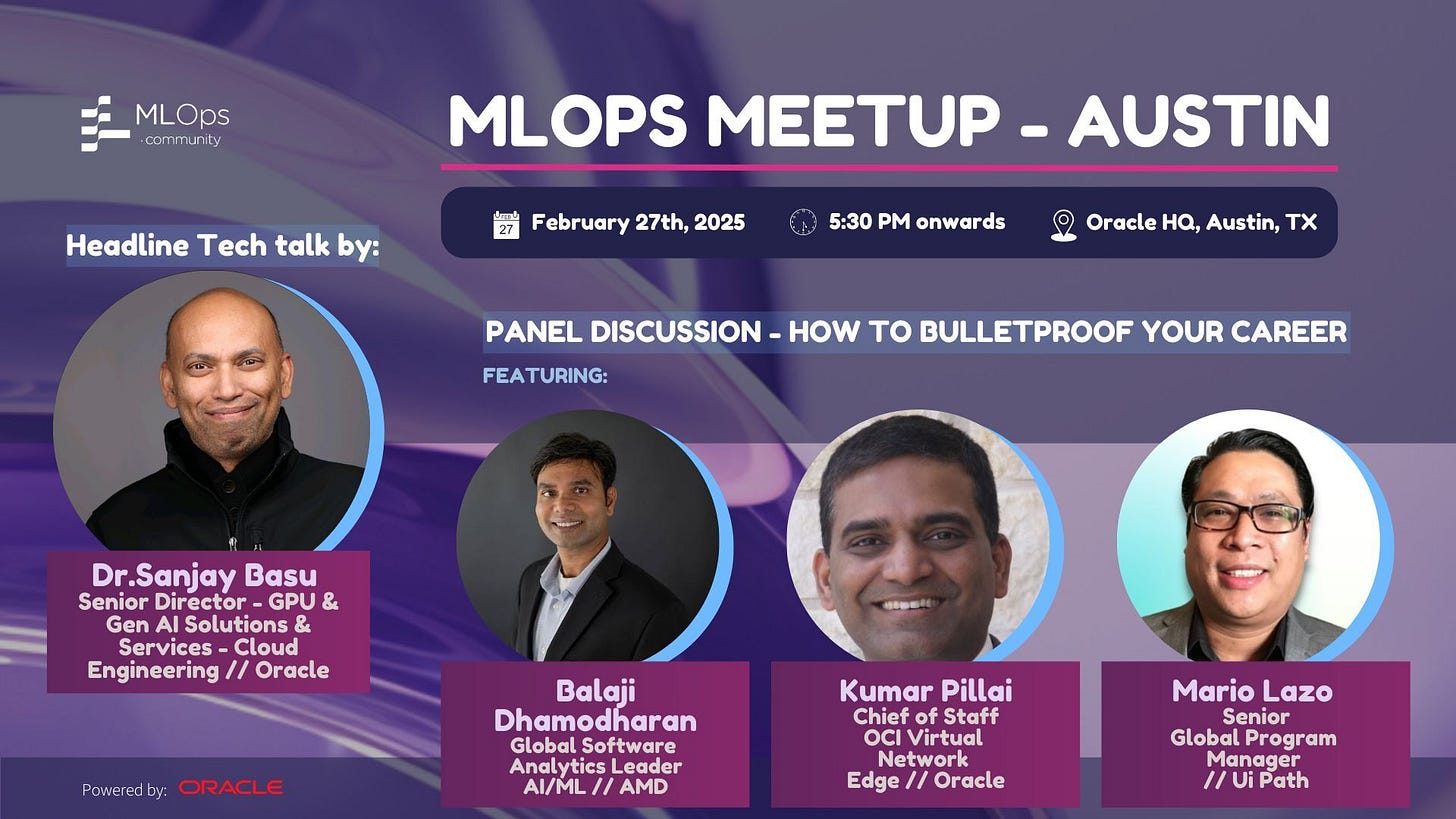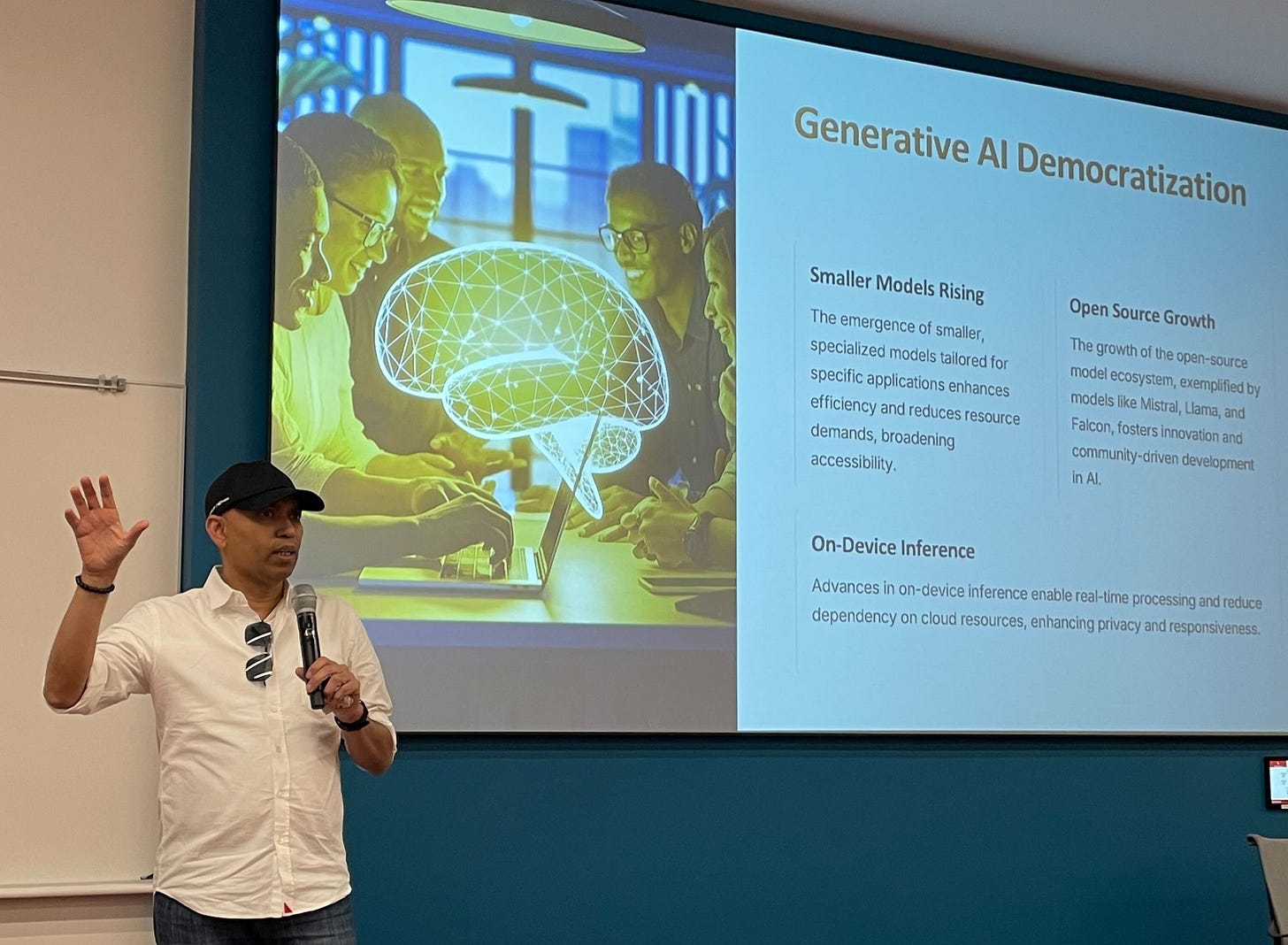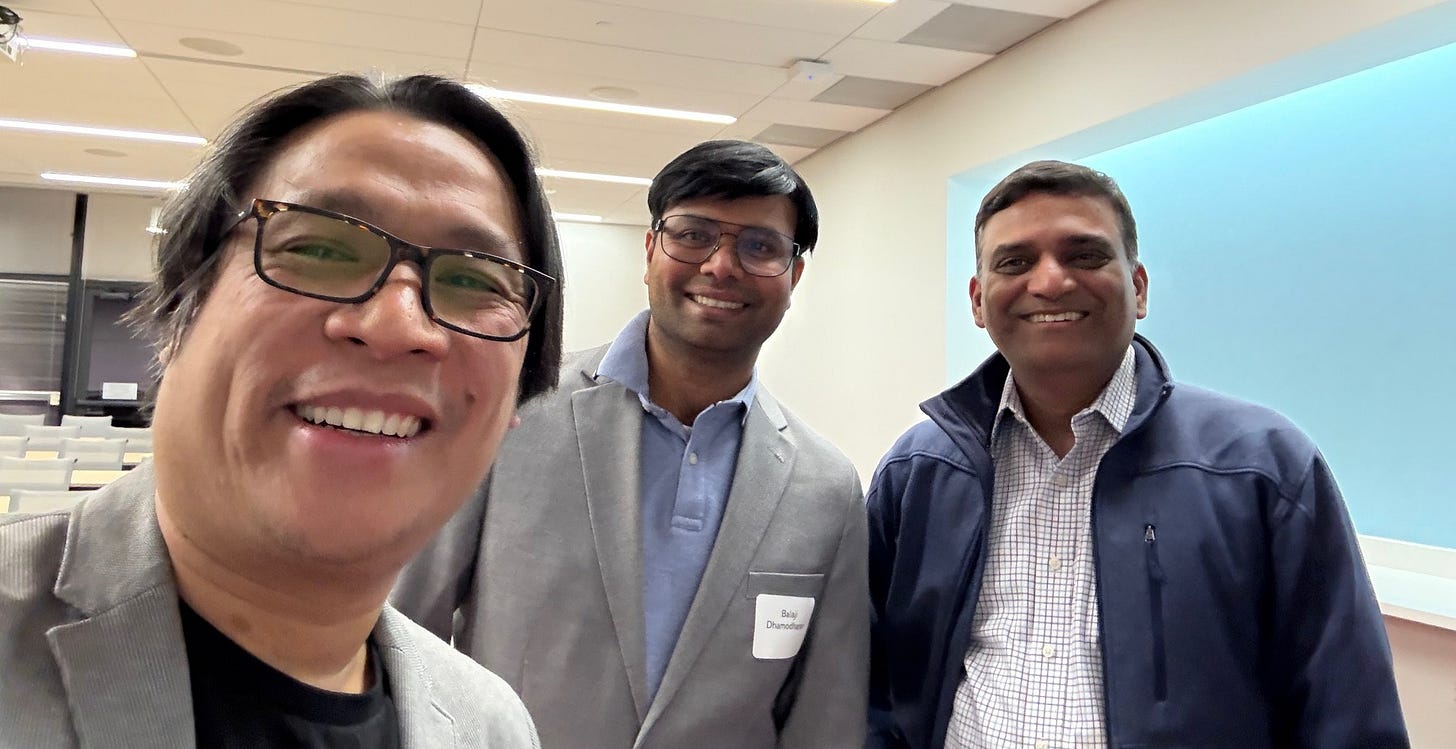Key Takeaways from the MLOps Community Austin Meetup: Thriving in the AI Era (Feb 27, 2025)
Last week’s MLOps Community Meetup at Oracle’s Austin campus wasn’t just insightful—it was electric. The room buzzed with 20+ audience questions, late-night discussions, and actionable strategies.
Key Takeaways from the MLOps Community Meetup: Thriving in the AI Era
Last week’s MLOps Community Meetup at Oracle’s Austin campus wasn’t just insightful—it was electric. The room buzzed with 20+ audience questions, late-night discussions, and actionable strategies for navigating AI-driven career shifts.
Here’s what resonated most:
The event kicked off with a visionary tech talk by Dr. Sanjay Basu, Oracle’s Senior Director of GPU & Gen AI Solutions, followed by a career resilience panel featuring leaders from AMD, Oracle, and UiPath.
The AI Evolution: From Foundation Models to Trustworthy Agents
Dr. Sanjay Basu opened the event with a deep dive into the rapid shifts reshaping AI infrastructure and capabilities. His talk highlighted three critical developments:
The Rise of Democratized Gen AI: Smaller 7B-13B parameter language models now rival larger counterparts for specialized tasks, while open-source innovation has exploded—over 250K models are publicly available today. Real-time on-device inference is unlocking latency-sensitive applications, from industrial IoT predictive maintenance to instant medical imaging analysis.
Solving the Agent Reliability Crisis: Basu identified persistent challenges plaguing AI agents:
Planning deficiencies (agents struggling with multi-step logic)
Tool reliability gaps (mishandling API errors)
Context management chaos (losing critical task memory)
Emerging Architectural Solutions: New frameworks are stabilizing agent performance:
Chain-of-thought reasoning creates audit-ready workflows (e.g., validating claims step-by-step)
React patterns enable self-correcting API integrations, akin to developers debugging in real time
Function-calling architectures enforce strict input/output boundaries, preventing memory leaks in complex workflows
Dr. Sanjay Basu’s tech talk painted a vivid picture of AI’s accelerating capabilities—smaller models democratizing access, edge computing enabling real-time decisions, and architectural breakthroughs solving agent reliability gaps which involved upskilling professionals.
The true test isn’t building smarter AI—it’s building skilled professionals who can wield it.
Navigating AI Disruption: Key Insights from Our Career Resilience Meetup
This set the stage for our career resilience panel, where industry leaders Balaji Dhamodharan (AMD), Kumar Pillai (Oracle), and Mario Lazo (UiPath) tackled the pressing question:
How do you bullet proof your career, when the roles that you are applying for have yet to be defined?
Here’s a distilled guide to future-proofing your career.
1. Embrace Continuous Learning and Upskilling
The rapid evolution of AI demands a proactive approach to skill development:
Pressure-test your market value: Regularly apply for jobs and attend interviews to gauge your relevance and identify skill gaps.
Focus on foundational concepts: Instead of chasing every new AI tool, understand core principles to adapt to technological shifts.
Leverage hackathons: These events offer hands-on experience with emerging tools and direct access to hiring managers.
“Stay paranoid about technological changes, but let that paranoia drive your learning.” — Kumar Pillai
2. Master the Art of Human-AI Collaboration
AI is a collaborator, not a replacement:
Augment, don’t fear: Functional consultants and programmers can use AI to boost productivity (e.g., automating repetitive tasks) while retaining oversight for critical decisions.
Build business acumen: Technical skills alone won’t suffice. Learn to align solutions with workflows and monetizable outcomes.
Trust but verify: Human accountability remains essential, especially in high-stakes fields like healthcare and finance.
3. Rethink Career Navigation Strategies
For job seekers:
Bypass ATS systems: Tailor resumes with keywords and network aggressively to secure direct referrals.
Nail the first 90 seconds: Interviews hinge on likability and competence—practice concise, value-driven storytelling.
For career pivots:
Hybridize roles: Explore intersections like AI-enhanced healthcare, where robots handle infection control while humans manage patient relationships.
Choose your path wisely: Individual contributors can thrive by solving high-impact problems, while managers must excel at guiding teams through change.
4. Leverage Networking and Personal Branding
Build authentic connections: Balaji Dhamodharan credits networking for his career transitions, emphasizing that relationships often trump resumes.
Showcase unique skills: Pursue passion projects and share insights publicly. As Mario Lazo noted, “Personal projects let you stand out in a sea of generic candidates.”
5. Prepare for the Future of Work
Entry-level challenges: AI is outperforming junior programmers, pushing new graduates to emphasize problem-solving and adaptability.
Leadership in flux: Managers must learn to implement AI tools without losing sight of organizational vision—a skill AI can’t replicate.
Infrastructure limits: Compute power and energy constraints mean widespread AI adoption will take time, giving professionals a window to adapt.
Final Thought
The panel’s urgency was palpable: AI won’t replace jobs—it’ll redefine them. Key survival traits emerged:
Learning Velocity: “Your ability to adapt is your greatest asset.” — Balaji Dhamodharan
Business Fluency: “Focus on the business value you bring, not just your technical stack.” — Kumar Pillai
Be that 10x super employee: “AI enhances productivity but can’t replace human judgment.” — Mario Lazo
As the clock neared 9 PM, the energy stayed high—proof that when professionals unite to dissect disruption, fear transforms into fuel.
The path forward?
Stay paranoid, stay curious, and build human connections no algorithm can replicate.





